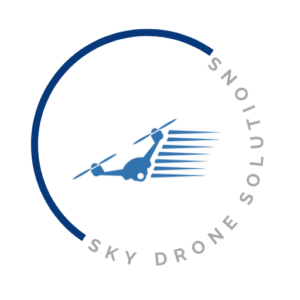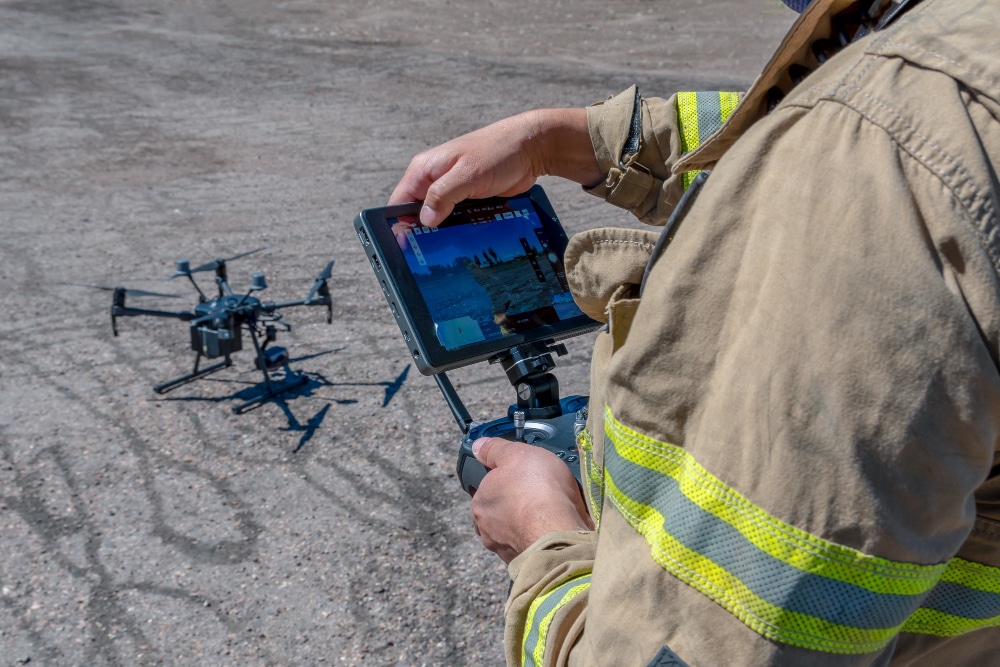Introduction to Drone Inspections and Their Benefits
As industries seek innovative solutions for asset management, drone inspections have emerged as a game-changer, offering significant benefits across various sectors.
Utilizing UAVs for inspections helps improve operational efficiency while reducing risks and costs. One significant benefit of drone inspections is their ability to access hard-to-reach areas without harming human inspectors, hence enhancing workplace safety and precision.
Drones provide a comprehensive overview of assessment sites, significantly improving the accuracy and reliability of inspections. This new inspection method enhances safety and offers substantial savings in time and costs, contributing to a positive ROI.
In the construction industry, UAVs are used for frequent detailed inspections that enable stakeholders to maintain deadlines and ensure quality. Similarly, drones deliver detailed imaging without disrupting services when inspecting power lines.
Moreover, their use in environmental monitoring aids researchers by providing valuable data for wildlife protection and conservation efforts. With these various use cases, it’s clear why drones are becoming indispensable tools in improving inspection efficiency and effectiveness across multiple industries.
As technology advances, drones’ role in inspections will continue to expand, offering even more significant benefits to businesses worldwide.
How Drones Are Revolutionizing Industrial Inspections: Real-World Case Studies
Drones are transforming industrial inspections by improving safety, reducing costs, and providing high-resolution data for better decision-making. Here are five real-world applications showcasing their impact:
Oil and Gas Facility Inspections
Traditional inspections of oil rigs and refineries require shutting down operations and exposing workers to hazardous conditions.
- Case Study: A major oil company used drones with thermal cameras to detect leaks and structural issues, reducing downtime and improving worker safety.
Power Line and Utility Infrastructure Monitoring
Inspecting power lines manually is dangerous and time-consuming, often requiring helicopters or climbing high-voltage towers.
- Case Study: A utility provider implemented drone inspections to assess transmission lines, cutting inspection time by 50% and reducing maintenance costs.
Bridge and Infrastructure Assessments
Aging infrastructure requires regular inspections, but manual assessments can be costly and disruptive to traffic.
- Case Study: A transportation agency deployed drones with LiDAR technology to map bridge structures, more accurately identifying critical wear and tear.
Construction Site Progress and Safety Checks
Ensuring construction projects remain on schedule and compliant with safety regulations is crucial.
- Case Study: A construction firm used drones for aerial mapping, reducing the time required for progress monitoring and enhancing site security.
Chemical Plant and Industrial Equipment Maintenance
Inspecting chemical storage tanks and processing equipment often involves confined space entry risks.
- Case Study: A manufacturing plant used drones to conduct internal tank inspections, eliminating the need for scaffolding and reducing inspection time by 75%.
These case studies demonstrate how drones are revolutionizing industrial inspections, making them safer, faster, and more cost-effective.
Inspecting Power Lines and Utility Poles
Drones have become integral in inspecting power lines and utility poles, offering unprecedented efficiency and safety. Traditional inspections often involve significant risks and costs.
With drones, inspections are faster and safer, reducing the need for manual climbing and minimizing human error.
Drone Inspections in Construction: Improving Accuracy and Reducing Costs
Construction managers also recognize drone technology’s benefits in improving accuracy and reducing costs.
Accurate data collection by drones ensures that every aspect of a construction site is documented meticulously, enhancing structural integrity and streamlining the inspection process. By reducing the time and effort spent on inspections, companies experience significant cost savings.
Furthermore, drones provide real-time imagery, which is invaluable in assessing the status of utility poles and construction sites. This additional layer of accuracy in inspections ensures that any potential issues with structural integrity are detected early, reducing the likelihood of costly repairs or downtime.
By embracing drone technology for inspecting power lines and utility poles and in construction, businesses improve safety and efficiency and achieve substantial cost reductions.
It’s clear that, for those managing extensive infrastructure, incorporating drones into their inspection strategy offers compelling advantages.
Ensuring Structural Safety: Drones in Bridge and Infrastructure Inspections
In recent years, drones have become crucial tools for ensuring the structural safety of bridges and infrastructures. These aerial devices provide a safe and efficient means for comprehensive inspections, particularly for detecting cracks, wear, and other structural weaknesses that could pose significant risks.
With their ability to access hard-to-reach areas, drones surpass traditional methods, which often require scaffolding or a risky human presence at heights.
By deploying drones, inspection teams can swiftly identify and document cracks, wear, and other signs of weaknesses. This approach enhances safety and promotes timely maintenance and repairs, reducing the overall risk associated with deteriorating infrastructure.
Through advanced imaging and sensors, drones gather high-resolution data, enabling detailed analyses to pinpoint vulnerabilities and optimize risk management strategies. This incorporation of drone technology aids bridge and infrastructure inspections by precisely detecting structural flaws, thus safeguarding public safety.
Sky Drone Solutions is at the forefront, harnessing the power of drones to revolutionize how we conduct inspections. With ongoing advancements, drones are set to become even more indispensable tools in maintaining the integrity of our invaluable infrastructure assets, ensuring that structural safety is prioritized.
The effective use of drones significantly impacts how infrastructure safety is managed today.
Reducing Risk: How Drones Improve Workplace Safety in Inspections
Implementing drones in inspections significantly reduces the risk of unsafe environments and improves workplace safety. Traditional manual inspections often pose safety risks, such as accidents and exposure to dangerous conditions.
Companies can minimize these risks by using drones, keeping human workers out of harm’s way. Drones can access challenging areas and inspect dangerous sites without exposing employees to threats.
For instance, when inspecting power lines, towers, and utility poles, drones capture detailed images from safe distances, reducing the chance of accidents linked to manual inspections. The decreasing need for workers to climb structures or enter precarious locations positively impacts safety outcomes.
Furthermore, incorporating drones reduces the chance of operational disruptions caused by accidents, maintaining consistent productivity. Drone inspections also facilitate obtaining precise data quickly, ensuring operations adhere to stringent safety standards.
This proactive approach to safety yields more comprehensive inspection results. It cultivates a safer work environment, thus reducing costs associated with workplace injuries and insurance.
Sky Drone Solutions continues to demonstrate the potential of drone technology in safeguarding workers while enabling efficient and thorough inspections. Adopting drones for inspections is a powerful strategy for mitigating risk, optimizing safety protocols, and achieving workplace safety goals effectively and efficiently in various industries.
Cost Savings and Efficiency: The ROI of Drone Inspections
Numerous case studies demonstrate that drone inspections offer significant cost savings and enhanced efficiency, leading to a favorable ROI. Businesses can achieve substantial financial benefits by integrating drone technology into various inspection processes.
Using drones reduces the need for human labor and heavy equipment, resulting in considerable operational benefits. These aerial tools minimize man-hours by allowing quicker inspections without sacrificing data accuracy.
Additionally, project management becomes more streamlined when drones are involved, as they provide real-time data and analytics, facilitating better decision-making. By speeding up inspection times, companies can devote their resources more efficiently and maintain project timelines.
The precise data collected by drones can help prevent costly errors that traditional inspection methods might overlook. Due to drone technology, industries ranging from construction to utilities see improved efficiency and lower operational costs.
With the ability to swiftly survey large areas, drones save time and significantly reduce the overall cost of inspections. Enhanced safety is an added benefit, as drones mitigate the risk of on-site accidents, adding to their financial advantages.
In essence, drone inspections provide a comprehensive solution that maximizes ROI through operational and financial benefits, reinforcing the case for their widespread adoption across numerous sectors.
Drones in Environmental and Wildlife Inspections
Drones have become indispensable in environmental and wildlife inspections, offering an innovative ecosystem monitoring and tracking approach. Their capacity to capture high-resolution images and videos enables scientists and researchers to perform precise assessments and inspections in diverse environments.
Through case studies, we’ve observed that drones facilitate the identification of environmental anomalies, such as deforestation and pollution, allowing for prompt rectification.
In wildlife inspections, drones are instrumental in observing animal behaviors with minimal disturbance to their natural habitat. This aspect is crucial for conservation efforts and helps track endangered species without invasive methods.
Drone technology and specialized software ensure efficient ecosystem monitoring, providing continuous and reliable data. Integrating drones in these inspections reduces costs and improves safety by minimizing the need for human presence in remote or hazardous terrains.
As the case studies show, drone-based inspections in the environmental and wildlife sectors are transformative. Implementing drones for ecosystem assessments enriches data accuracy, giving conservationists and environmentalists a powerful tool for positively impacting global efforts.
Undoubtedly, drone services like those offered by Sky Drone Solutions continue to demonstrate their irreplaceable role in enhancing our understanding of and interaction with the natural world.
The Future of Aerial Inspections: AI-Powered Drones in Action
The future of aerial inspections is rapidly advancing, with AI-powered drones taking center stage in transforming industries. Sky Drone Solutions is at the forefront of this shift, offering sophisticated sensor technology and AI data analysis to enhance inspection accuracy and efficiency.
These drones are equipped to handle predictive maintenance, identifying potential issues before they cause costly failures.
By employing AI in inspections, businesses can anticipate problems through sophisticated testing methods that surpass traditional techniques in reliability and precision. AI-powered drones with high-resolution sensors deliver comprehensive insights, reducing human error and the risk associated with manual inspections.
The benefits extend to various sectors. AI allows for continuous improvements and adaptation, ensuring meeting safety and compliance standards. As more industries adopt this technology, the practical applications of aerial inspections continue to expand, driven by the data-driven insights drones provide.
AI enhances current processes and revolutionizes how we approach inspections, paving the way for safer and more cost-effective practices.
Sky Drone Solutions is committed to leveraging AI and other advanced technologies to meet businesses’ evolving needs and ensure continued competitiveness in the marketplace.
Stay tuned as AI-powered drones become integral to the future of aerial inspections.

